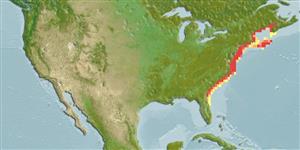Environment: milieu / climate zone / depth range / distribution range
Ökologie
seewasser; süßwasser; brackwasser demersal; anadrom (Ref. 51243); tiefenbereich 6 - 53 m (Ref. 93286), usually 6 - 34 m (Ref. 93286). Subtropical; 49°N - 28°N, 82°W - 65°W (Ref. 54259)
North America: St. John River in Canada to St. Johns River in Florida, USA.
Length at first maturity / Size / Gewicht / Alter
Maturity: Lm 50.0, range 45 - 55 cm
Max length : 143 cm TL Männchen/unbestimmt; (Ref. 6866); common length : 50.0 cm TL Männchen/unbestimmt; (Ref. 12193); max. veröff. Gewicht: 23.0 kg (Ref. 6866); max. veröff. Alter: 67 Jahre (Ref. 6866)
Rückenflossenstacheln (insgesamt) : 0; Rückenflossenweichstrahlen (insgesamt) : 33 - 42; Afterflossenstacheln: 0; Afterflossenweichstrahlen: 18 - 24. Snout short, bluntly V-shaped, not upturned at tip. Barbels short (Ref. 7251). Absence of fontanelle and post dorsal shields. Single row of pre anal shields, 6-11 (Ref. 4639). Dorsal shields 7-13, lateral shields 22-34 (Ref. 4639). Blackish viscera (Ref. 37032). Head and back dark, lower surface white (Ref. 37032). Anal fin origin beneath dorsal fin origin (Ref. 86798).
Inhabit river mouths, lakes, estuaries, and bays; occasionally enters the open sea. Feeds mostly at night over soft substrates; juveniles feed primarily on benthic crustaceans and insects, adults prey on benthic crustaceans, insects and mollusks (Ref. 93252). Maximum known age is 67 years for females and 30 years for males. Flesh of good quality; eggs are suitable for caviar (Ref. 3192).
Page, L.M. and B.M. Burr, 1991. A field guide to freshwater fishes of North America north of Mexico. Houghton Mifflin Company, Boston. 432 p. (Ref. 5723)
IUCN Rote Liste Status (Ref. 130435)
Bedrohung für Menschen
Harmless
Nutzung durch Menschen
Fischereien: weniger kommerziell; Sportfisch: ja; Aquarium: Öffentliche Aquarien
Tools
Zusatzinformationen
Download XML
Internet Quellen
Estimates based on models
Preferred temperature (Ref.
123201): 7.5 - 25.5, mean 15.6 °C (based on 138 cells).
Phylogenetic diversity index (Ref.
82804): PD
50 = 0.5000 [Uniqueness, from 0.5 = low to 2.0 = high].
Bayesian length-weight: a=0.00324 (0.00142 - 0.00736), b=3.17 (2.99 - 3.35), in cm total length, based on LWR estimates for this Genus-body shape (Ref.
93245).
Trophic level (Ref.
69278): 3.3 ±0.39 se; based on food items.
Widerstandsfähigkeit (Ref.
120179): sehr niedrig, Verdopplung der Population dauert mehr als 14 Jahre. (K=0.04; tm=14-17; tmax=67; Fec=48,000).
Fishing Vulnerability (Ref.
59153): Very high vulnerability (86 of 100).
